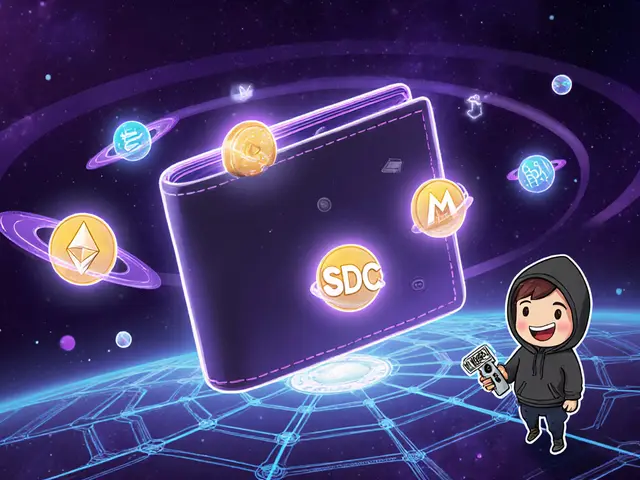When massive crypto holdings jump on or off an exchange, the market takes notice. Those moves-known as whale deposits and withdrawals-can trigger price spikes, thin order books, and even shift sentiment across the entire ecosystem. Below you’ll find a practical guide that explains what these flows mean, how analysts spot them, and what you can do with the information.
What Exactly Are Whale Deposits and Withdrawals?
Whale is a term for an address or entity that holds a large amount of cryptocurrency, typically 1,000+BTC or the equivalent in other coins. Whales are powerful because moving even a small fraction of their holdings can swing market liquidity dramatically. A Deposit refers to the transfer of funds from a private wallet into an exchange's hot or cold wallet, making the assets readily tradable. A Withdrawal is the opposite-funds leave the exchange and return to a private address, often implying a hold‑off‑selling strategy.
For Bitcoin, a whale usually means an address with at least 1,000BTC (about $68million at current prices). For Ethereum, the threshold jumps to roughly 10,000ETH (around $28million). These numbers come from the Glassnode Whale Size Subdivisions metric, which categorises whales into sub‑groups based on on‑chain balances.
How Analysts Spot Whale Movements
Tracking whales relies on on‑chain explorers and specialized analytics platforms. The most widely used tools include:
- Glassnode - provides real‑time metrics such as the Exchange Inflow Mean, Whale Deposit/Withdrawal Volume Ratio, and the Accumulation Trend Score.
- Lookonchain - focuses on wallet clustering, letting users see which addresses belong to the same entity (e.g., Mt.Gox‑related wallets).
- Nansen - offers alerts for movements exceeding $10million and visualises token holder composition.
- Santiment - tracks “whale watching” signals and ties them to macro variables.
Key metrics to monitor:
- Exchange Inflow Mean - average size of deposits in a given period. A jump from ~0.7BTC to >6.8BTC often precedes selling pressure.
- Whale Deposit/Withdrawal Volume Ratio - compares total deposited value against withdrawn value. Ratios above 100% signal net accumulation.
- Accumulation Trend Score - ranges 0 (distribution) to 1 (strong accumulation). Scores above 0.8 have historically aligned with upcoming price rallies.
- Whale Reshuffling - tracks short‑term balance shifts among whale sub‑groups, revealing whether large holders are moving funds between exchanges or consolidating in cold storage.
Market Impact: Deposits vs. Withdrawals
When whales funnel funds into an exchange, they increase the available supply on the order book. In a thin market-where the top 100 wallets control roughly 15% of circulating Bitcoin-an extra $50million can move the price 5‑7%. This phenomenon is documented by Bitcoin.tax, which notes that large deposits often precede short‑term sell‑offs as the assets become market‑ready.
Conversely, massive withdrawals tighten liquidity. With fewer coins on‑exchange, even modest buy orders can push prices up, creating a self‑reinforcing bullish loop. Community sentiment on Reddit’s r/CryptoMarkets (September2023) showed 68% of respondents associate withdrawals with bullish expectations, while 22% see them as pre‑sale positioning.
Regulators are paying attention, too. The SEC’s March2023 guidance warned that coordinated whale deposits could skirt market‑manipulation rules, though enforcement remains a gray area.
Historical Case Studies
| Event | Whale Action | Approx. Value | Resulting Market Move |
|---|---|---|---|
| Mt.Gox Dormant Wallet (July2023) | 300BTC deposited to Binance | $33.5M | Immediate 4% BTC rally as traders anticipated influx |
| 2021 Bull Run Peak (Nov2021) | 185,000BTC deposited across exchanges | ~$9.5B | Follow‑up correction of ~15% in Dec2021 |
| 2022 Bear Market (Jun‑Dec2022) | 500,000BTC withdrawn | $13B | Liquidity crunch, price dip to $15k |
| Terra/LUNA Collapse (May2022) | 7 major whales moved $40B total | $40B | Market crash across multiple assets |
These examples illustrate a recurring pattern: deposits often hint at upcoming selling pressure, while withdrawals can signal either confidence or preparation for a coordinated sell‑off. The context-market cycle, macro news, and the specific whale subgroup-determines the true meaning.
Interpreting Whale Signals: Bullish or Bearish?
Two major schools of thought dominate the discussion:
- Accumulation View - High deposit ratios (e.g., >100%) combined with a rising Accumulation Trend Score suggest whales are loading up for a future rally. Glassnode’s September2023 report linked a 0.87 score to the run‑up ahead of the 2024 Bitcoin ETF approvals.
- Profit‑Taking View - The same deposit surge can be a pre‑sale move, especially if the Exchange Inflow Mean spikes sharply. CoinDesk’s Jan2023 analysis warned that a sudden deposit surge often foreshadows near‑term profit taking.
Practical interpretation requires cross‑checking multiple metrics. For instance, a deposit surge paired with a falling Whale Reshuffling score (large‑holder >10kBTC distributing) leans bearish, whereas the same surge alongside steady or rising scores for the 1k‑10kBTC group points bullish.
Practical Checklist for Traders
- Set up real‑time alerts on Nansen for movements >$10M.
- Monitor the Exchange Inflow Mean. A jump >10× baseline flags potential sell pressure.
- Check the Whale Deposit/Withdrawal Ratio. Ratios above 120% usually indicate net accumulation.
- Cross‑reference with macro news (ETF filings, regulatory updates) to gauge intent.
- Observe the Accumulation Trend Score. Scores above 0.8 for the 1k‑10kBTC group are bullish; scores below 0.4 signal distribution.
- Watch the Whale Reshuffling metric for short‑term balance shuffles; rapid shifts can precede volatility spikes.
- Consider the exchange type: deposits to centralized exchanges (e.g., Binance, Coinbase) carry different implications than moves to DeFi platforms (e.g., staking on Lido).
Following this checklist helps you turn raw on‑chain data into actionable trade ideas while avoiding over‑interpretation.
Future of Whale Monitoring
Analytics firms are already incorporating AI‑driven prediction models. Glassnode’s upcoming Whale Behavior Prediction Algorithm blends deposit/withdrawal patterns with macro indicators, claiming 68% accuracy for 7‑day price forecasts. Meanwhile, cross‑chain bridges are adding a new layer of complexity-Arkham Intelligence notes that about 12% of whale moves now span multiple blockchains, demanding multi‑network monitoring tools.
DeFi also reshapes whale behavior. Large holders increasingly allocate assets to yield farms or staking contracts instead of sending them to centralized exchanges, a trend highlighted in OneSafe.io’s Ethereum analysis of Kraken withdrawals. This shift reduces the immediate market impact of withdrawals, making on‑chain signals more nuanced.
As the ecosystem evolves, the core principle remains: massive on‑chain flows are a leading indicator of market sentiment. Staying equipped with the right tools and a multi‑metric approach will keep you ahead of the curve.
Frequently Asked Questions
What defines a crypto whale?
A whale is an address that holds a large quantity of a cryptocurrency-typically 1,000+BTC or 10,000+ETH. The exact threshold varies by coin but always represents a share large enough to move market liquidity when transferred.
How can I get real‑time whale alerts?
Platforms like Nansen, Santiment, and Lookonchain let you set custom thresholds (e.g., any movement >$10M). Most offer Discord or email notifications the moment a qualifying transaction hits the blockchain.
Do whale deposits always mean prices will drop?
Not always. A deposit can signal preparation to sell, but it can also indicate accumulation if the whale plans to hold the assets on‑exchange for future buying pressure. Look at the accompanying metrics-Exchange Inflow Mean, Accumulation Trend Score, and Whale Reshuffling-to gauge intent.
Why are withdrawals sometimes seen as bullish?
When whales pull funds out of exchanges, the on‑exchange supply shrinks, tightening order books. With fewer coins available for sale, even modest buying pressure can push prices up, creating a bullish environment.
Can institutional investors be considered whales?
Yes. Institutional players like BlackRock or Fidelity often move tens of millions of dollars in crypto. They usually operate through OTC desks to avoid flooding exchanges, which makes their on‑chain whale signals less obvious but still impactful.



12 Comments
Chloe Jobson
Whale deposits are never just about selling. Always check the Accumulation Trend Score first. If it's above 0.8, you're looking at accumulation, not exit strategy. Glassnode's data backs this up every cycle.
Andrew Morgan
bro i just watch the big moves on lookonchain and if something over 10k btc hits binance i just short it no thinking needed
Michael Folorunsho
Most retail traders don't understand that whale behavior is contextual. You can't just look at inflows. You need to know if it's a sovereign wealth fund, a hacked wallet, or a centralized exchange rebalancing. The fact that you're even asking suggests you're still in the 'chart wizard' phase.
Roxanne Maxwell
Love how this breaks it down so clearly. I always get confused between deposits and reshuffling but the checklist at the end? Pure gold. Saved it for my next trade session 💛
Jonathan Tanguay
you guys are missing the real point here the entire premise is flawed because you're still using outdated metrics from 2021 the market has changed the whale definition has evolved and now its not about btc amount its about liquidity depth and exchange tiering like if a 5k btc move hits okx vs binance vs kucoin the impact is totally different and nobody talks about that also the accumulation score is garbage because it doesnt account for cross chain transfers and you all are still stuck in bitcoin only thinking and that's why you keep getting burned also why are you ignoring the fact that institutions are using otc desks now so most of the real whale moves are invisible to on chain tools and you're all just chasing ghosts with glassnode alerts and you think you're smart but you're not
Ayanda Ndoni
why do you even care about whales? they dont even trade the same coins as us. i just buy when its cheap and sell when its high. why make it complicated?
Elliott Algarin
There's something poetic about how these massive on-chain movements mirror human behavior-accumulation as patience, withdrawal as conviction. We're not just tracking wallets, we're observing collective psyche. The market isn't driven by price, it's driven by belief. And whales? They're just the loudest believers.
John Murphy
That whale reshuffling metric is underrated. Saw it drop hard before the last rally. Not sure why more people don't track it. It shows whether the big holders are consolidating or scattering. If they're moving between exchanges, it's chaos. If they're going cold, it's quiet power.
Zach Crandall
While the analytical framework presented is methodologically sound, I must emphasize the structural asymmetry inherent in centralized exchange dynamics. The concentration of liquidity within a handful of platforms introduces systemic risk that is neither quantified nor mitigated by the metrics cited. One must consider the regulatory arbitrage facilitated by jurisdictional fragmentation of exchange infrastructure.
Akinyemi Akindele Winner
Whales? More like whale-sized ghosts haunting our charts with fake signals. In Nigeria we call this 'market juju'-people praying to blockchain gods and calling it analysis. You think a 10k BTC move means anything? I've seen guys move 50 BTC on Binance and crash the market because 1000 noobs panic-sold. Stop overthinking. Just watch the order book. That's where the real magic happens.
Patrick De Leon
Using Nansen alerts? Amateur. Real traders use proprietary blockchain node clusters with custom clustering algorithms. You're all just copying Glassnode's dashboard like sheep. And don't get me started on Reddit 'analysts'-you think a 68% sentiment score means anything? That's just noise from people who don't even know what a UTXO is.
Chloe Jobson
Actually, the DeFi shift changes everything. When whales move to Lido or Aave instead of exchanges, it’s not withdrawal-it’s yield farming. That’s why withdrawal volumes are misleading now. You need to track staked balances too. The old rules don’t apply anymore.